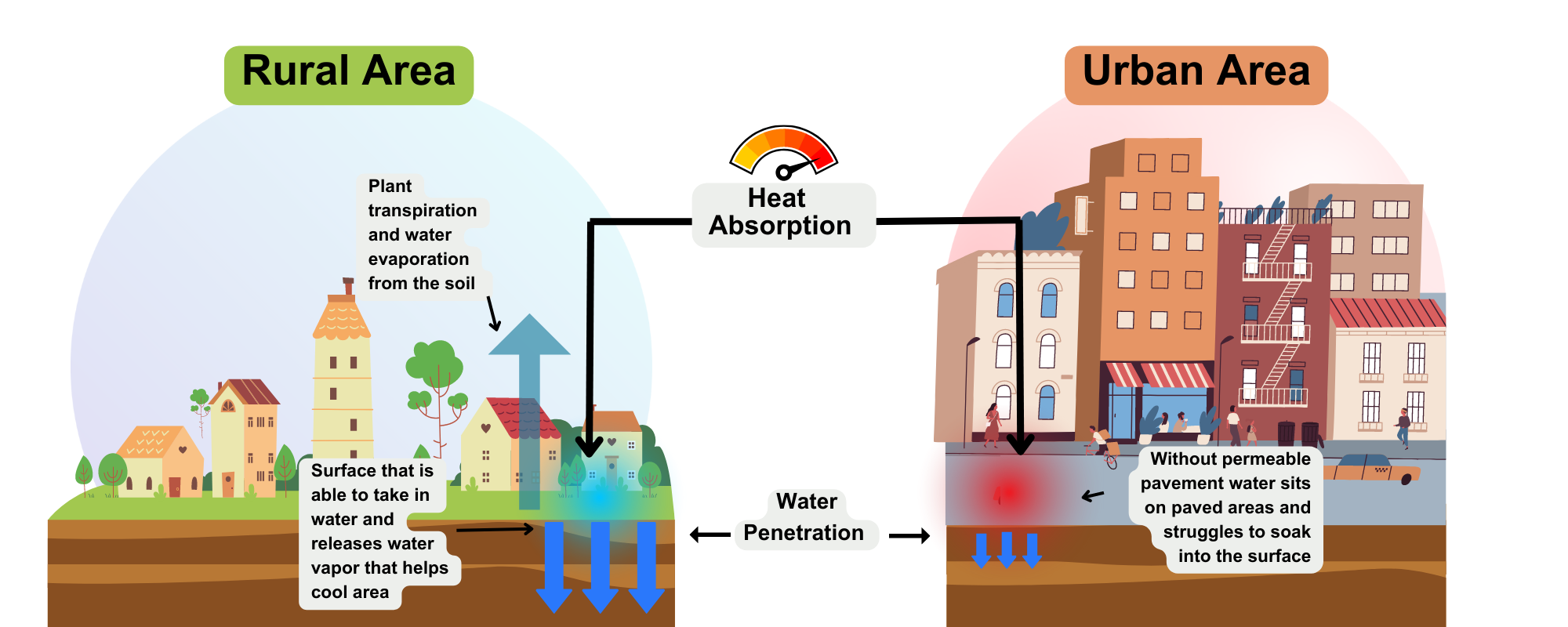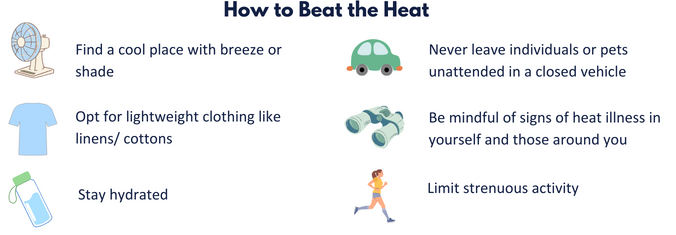Cities often feel significantly hotter than surrounding rural areas due to the urban heat island (UHI) effect. Urban heat islands are caused by the concentration of surfaces that retain and absorb heat, such as buildings, roads, and pavement. As with many other cities, Sarasota is experiencing the UHI effect and would benefit from tree installations and adding green spaces to help offset the heat caused by the prevalence of concrete surfaces. Read on to learn more about extreme heat, vulnerable populations, and what to do to stay cool.
Unveiling the Weather Transformation in Sarasota
During the summer months, residents and visitors in Sarasota experience soaring temperatures. While some may think that the extreme heat just comes with the season, the unprecedented temperatures are also a result of climate change. Rising temperatures, extreme heat waves, and prolonged periods of hot weather have become increasingly common. Sarasota has experienced a significant increase in high-heat days, with the number rising from 35 to 64 annually since 1960. These changes can be attributed to the overall warming of the planet caused by greenhouse gas emissions coming from a variety of sources including burning fossil fuels, deforestation, and other industrial processes.
Understanding the Urban Heat Island Effect

The urban heat island effect occurs due to the contrast between natural landscapes and urban infrastructure. Unlike forests and water bodies, which absorb and dissipate the sun’s heat effectively, structures such as buildings, roads, and pavements in urban areas tend to absorb and re-emit heat, creating pockets of higher temperatures. Urban areas are usually 2-5°F warmer than rural areas at night, a crucial time when the earth should be able to cool down. This significant temperature difference is particularly noticeable during the hottest month of the year, which in Sarasota happens to be August.
Moreover, the urban heat island effect contributes to the loss of native species. As temperatures rise, some plants and animals that are adapted to cooler conditions struggle to survive. This disruption to local ecosystems can have cascading effects on biodiversity and ecological balance.
In addition to the environmental and health impacts, the urban heat island effect places an increased energy burden on our community, especially families facing financial hardship. Higher temperatures lead to greater demand for air conditioning, resulting in increased energy consumption. This, in turn, leads to higher electricity bills for residents. Addressing the urban heat island effect can help alleviate this burden and promote sustainable energy usage.
Who is most affected?
Certain populations are more vulnerable to the negative effects of heat.
- Vulnerable People Groups: Elderly, young children, pregnant women, and individuals with pre-existing medical conditions have specific characteristics or circumstances that make them more susceptible to the negative impacts of extreme heat. These include medication side effects, lack of mobility, reduced body heat regulation, and more.
- Outdoor Workers: Outdoor workers, such as construction workers, landscapers, prison laborers, and agricultural laborers, face a higher risk of heat-related illnesses due to their prolonged exposure to direct sunlight and physically demanding tasks. Implementing safety measures and providing adequate breaks and shade are essential to protect their health.
- Communities with Limited Green Space: The absence of trees and vegetation intensifies the urban heat island effect, resulting in elevated temperatures and diminished comfort in these regions. Studies indicate that economically disadvantaged communities are the most “nature deprived”, as they have fewer parks, and streets adorned with trees and grassy areas in their backyards. It is imperative to tackle this inequality and advocate for the establishment of additional green spaces within these communities.
How to Keep Yourself Cool

Taking Action
Fortunately, there are measures we can take to mitigate the urban heat island effect and create a more sustainable and livable environment.
Home Design
Ensuring proper insulation for your home, helps keeps hot air out during the scorching summer months and traps warm air inside during winter, resulting in a comfortable living environment year-round. Additionally, investing in energy-efficient appliances and equipment helps curb high energy bills while promoting sustainability. Lastly, strategically planting trees around your house adds aesthetic value and provides shade and natural cooling, contributing to a more enjoyable and cost-effective summer season.
Volunteer
Volunteering with tree-planting groups is an excellent way to take meaningful action. The Florida Veterans for Common Sense and various other organizations have collaborated to establish micro forests, with their first thriving plantation located in celery fields. The micro forest enhances the beauty and biodiversity of Celery Fields, a highly valued recreational area. Runners and walkers can now enjoy the refreshing shade provided by the forest, offering respite from the sun-drenched open spaces.
Donate
Supporting homeless shelters through donations is a wonderful way to assist those who are less fortunate and may lack adequate resources to cope with extreme heat. Donating items such as water bottles, light-colored loose clothing, umbrellas, hats, and battery-operated fans can make a significant difference. A homeless shelter in Sarasota that accepts donations is The Resurrection House.
Be Aware
Knowing which people in your life are more prone to heat stress can help you provide better support when temperatures rise and pose a health risk. Besides advocating for climate action, the simplest and most helpful thing we can do during hot weather is to check on vulnerable individuals before it becomes a crisis. Be aware and look for signs of heat-related illness like sweating, cramps, weakness, fatigue, nausea, dizziness, headache, or fainting, make sure to check on them and offer water.
Education
Learn about the effects of heat to prepare yourself and educate others. UF/IFAS Extension Sarasota County offers educational classes to build a knowledgeable community. These classes are open to all and help develop skills, solve problems, and promote a greener future. Upcoming energy efficiency and climate change classes are particularly beneficial for those interested in heat-related topics. Register and browse other courses below.
https://www.eventbrite.com/o/ufifas-extension-sarasota-county-422952084
Takeaways
Community engagement and awareness are vital in combating extreme heat. By promoting the importance of planting trees and urban green spaces and encouraging energy-efficient practices, we can collectively work towards creating a cooler and more sustainable Sarasota.

Resources
- Climate Challenges: Sports (rack card)
- Climate Challenges: Sports (video)
- Red Cross Emergency App
- OSHA Heat Safety Tool App
- NYT “How Much Hotter is Your Hometown Than When You Were Born?” Tool
- United States Department of Energy
- United Nations
Sources
 6
6
